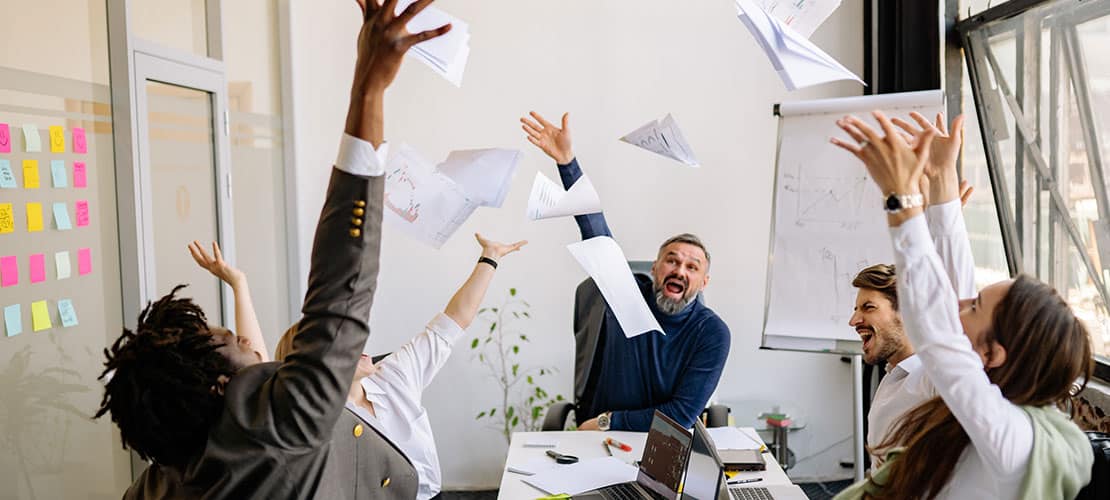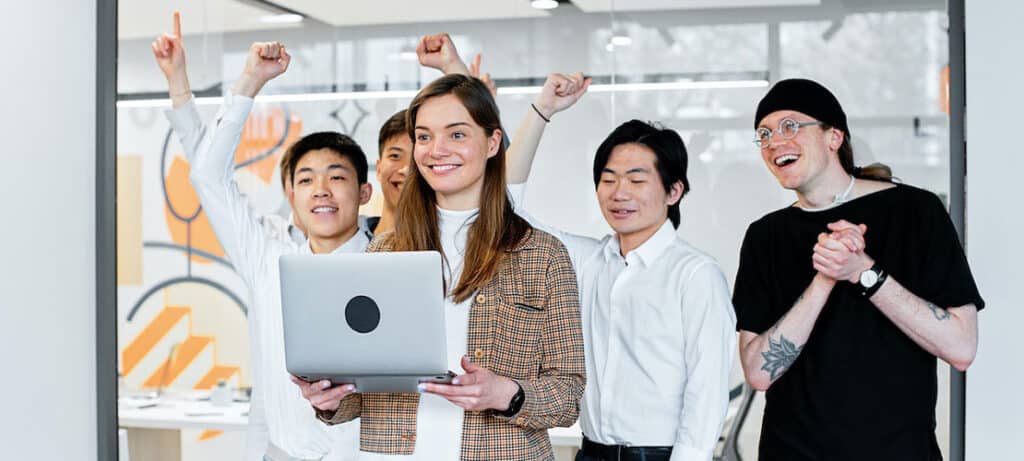What Is Gamification?

Gamification is the process of applying game design techniques to non-game contexts. It’s used to make the work process more engaging, interesting, and fun.
Gamification gives people something more rewarding and exciting to do that can help them in their work. It can be used as an incentive or reward system to make certain tasks more engaging and fun for specific groups of people.
Gamification has taken off massively in the last decade. A market study on the global gamification market anticipates gamification to breach $30 billion in value in 2025.
Companies typically use gamification to improve productivity and output in areas such as marketing, sales, events, and customer service. Making a process into a game, or making the task more fun, can increase motivation, reduce stress and anxiety levels.
Gamification is often confused with gaming in terms of features and form factors. Where gaming refers to playing video games, gamification is primarily associated with non-gaming activities.

How does gamification work?
Think about the times when you played a game on your mobile device while waiting in line at your bank or riding the subway. You get rewarded with rewards or experience points for completing those tasks successfully so that you can level up and get access to better rewards later on in the game.
Gamifying work elements functions in the same way, except on a much bigger scale.
For instance, gamification of a company’s performance metrics allows employees who consistently make their numbers to be rewarded with incentives such as a promotion, a bonus, or even an increased salary.
What are game mechanics?
Game mechanics are the rules that define how participants interact with the game. Some common game mechanics include leveling up, collecting items, and winning trophies.
Having solid game mechanics is a vital precursor to a successful gamification. These rules can be simple or complex, and they can be used for different purposes, such as promoting a healthy lifestyle, increasing customer loyalty and retention, or changing employee behavior.
Sound game mechanics:
- Makes it easier for people to follow through with the desired actions.
- Brings structure and clarity to otherwise unclear goals.
- Provides a sense of accomplishment when completing tasks.
What are game design elements?
Game design elements are the main parts of gamification. They are the basic concepts that make up the structure of a game and are often described by the specific tasks they perform in a game.
These could be leaderboards for friendly competition, team missions to work on, a news feed to learn about other players, a badge system to display one’s accomplishments, and secret missions to keep players on their toes. When game mechanics and game elements are put together, they make a powerful tool for increasing immersion, participation, and motivation from within.
The key game elements

When adding game elements to a non-game setting, the following three gamification elements get people most excited:
Points
Points are one of the most common game elements in gamification. Participants can get them for doing a certain task or reaching a certain goal. Participants can be awarded points based on their rank or simply given a certain number of points.
Achievements are similar to points but tend to be more involved than other game elements and represent the participant’s progress in a game. They generally require participants to unlock or progress through levels for them to unlock.
Badges
Badges are another type of game element that is often used in gamification. They are usually given to participants for completing a specific task or achieving a specific goal. Badges can be given for games, social media achievements, or for achieving game-related missions.
Leaderboards
Leaderboards show how well players have performed against their peers in games like chess and other competitive games. It’s also common for companies to use different leaderboards for co-operative games, which have the leaderboard showing how well the team has done against other teams. A leaderboard may also be shown on its own without the participant’s performance in mind, such as one that is related to achievements.
What is Gamification in Sales?
Gamification in sales is a strategic approach that applies game design elements and principles to the sales environment to motivate and engage sales teams, ultimately driving sales performance and productivity. It leverages the natural human propensity for competition, achievement, and collaboration, transforming routine sales activities into engaging and motivational experiences.
By integrating elements such as points, badges, leaderboards, challenges, and rewards into sales tasks and objectives, gamification fosters a competitive yet collaborative atmosphere that not only motivates individual sales representatives but also promotes team cohesion.

Does gamification improve employee engagement?
Employees who are engaged in their work tend to be more productive and happy. With gamification, companies can encourage their workers to always do their best and do the best work they can. In one of their studies, Salesforce found a dramatic 60% increase in employee engagement post-gamification.
Effective gamification improves employee engagement by:
- Providing an opportunity for employees to feel like they have a stake in their company’s success.
- Giving employees autonomy and choice.
- Encouraging collaboration among peers, coworkers, and team members.
- Improving their productivity, focus, and commitment towards individual, team, and company’s common goals.
A Harvard Business School study uncovered a range of benefits too. Gamification adds game-like elements like points, badges, levels, leaderboards, and rewards to make even the most boring tasks more fun and rewarding for the user. Gamification boost user engagement but also with productivity and customer satisfaction.
Gamification examples
Several big-shot brands around the world have already integrated gamification into their businesses for its versatility and knack for delivering remarkable results. Gamification does more than just improve performance; it also makes people more loyal to a brand and gets them more involved with it.
One can go on and on about all the gamification the likes of Uber, Airbnb, Tesla Motors, L’Oréal, and even NASA have adopted. This is the kind of ongoing trend that is most likely to increase the adoption of gamification, considering how well these companies are doing.
RE/MAX Accent
RE/MAX Accent is read estate agency based
Savannah-based real estate agency RE/MAX accent broke their sales record through gamification. It’s one of Spinify’s most recent examples of gamification success.
Their sales teams could see their real-time performance on Spinify leaderboards of huge TVs spread across the workplace. The result: they hit their sales quicker than they had anticipated.
Adding gamification elements to mundane tasks not only helps increase participation and encourage engagement but also gives a reason to the sales team to deliver their best.
Spinify’s gamification of their work processes and assigning experience points to non game activities created a healthy and a competitive environment.
Marriott gamified their recruitment process
Marriott is a hospitality company with over 4,000 hotels in over 100 countries. They wanted to improve their hiring and get more millennials to join their team. To do this, they had to use the best practices for gamification recruitment.
So, they created the My Marriott Hotel app, which allows candidates to play games to get noticed by hiring managers.
Candidates get a chance to run a virtual hotel, manage their inventory, train their teams, and keep their guests delighted. They win points for a job well done and lose points for poor customer service or a disgruntled customer.
The app helps Marriott’s recruiters find the right talent for their hotels because their gamification design and the mechanics have already evaluated their skill sets.
As of now, this app has helped Marriott hire over 10,000 new employees across all of its properties worldwide since its inception.
Reddit gamified blogging and sharing content
Reddit is one of the most popular websites on the internet. The platform owes its stupendous success to the way it implements gamification in blogging, posting, and content-sharing.
The site uses game mechanics to encourage people to take action. This includes giving users points for taking an action, such as upvoting or downvoting, rewarding them with badges when they accomplish certain goals, and engage users and reward them with karma points when they post content that other users upvote.
Users can also buy coins and gifts and give them to the user whose content they like. Because gamification fuels everything on Reddit, it becomes more appealing for user content to be seen by others, which leads to more karma points and badges, and ultimately, higher engagement.
Domino’s Pizza gamified their training process
Domino’s Pizza has been using gamification and gamification-based training to improve their customer service. Their online Pizza making course, The Pizza Maker, is a fun and engaging environment with a competitive edge.
The course is designed for anyone who wants to learn how to make pizzas, whether they are seeking employment or already have one and are looking for a new skill. The idea was that by adding a game element to video lessons, quizzes, and hands-on practice, it would make learning fun and interactive for everybody. It also helped them figure out who would be the best person for each job in the company.
Their gamification of the training process creates an engaging experience that keeps learners motivated and interested throughout the training process. As a result, Domino’s Pizza experienced an increase in the number of students signing up for the course, as well as improved retention.
Microsoft gamified language localization
For years, Microsoft had struggled with inaccurate translation of menu items in their suite of apps. The problem was not just that they were inaccurate, but that some translations made no sense at all—particularly in Japanese and Chinese.
Their solution? They turned to gamification.
Microsoft gamified language localization to create and maintain a high-quality translation. They built a “Language Quality” game which allows Microsoft employees from all over the world to view screens and verify language accuracy with ease.
Over 4,500 employees participated and corrected translations on over 500,000 screens. Microsoft being Microsoft, they even sprinkled in some hilariously wrong translations to make people laugh and keep them coming back.
Nike gamified fitness training
Nike has a long history of using technology and gamification to motivate people and make them healthier. In the past, they have used gamification as a way to encourage people to be more active by getting them into fitness training games such as Nike+ Running or Nike+ Training Club.
Nike is currently using gamification for their new Nike+ Run Club app, which aims to help runners improve their performance and get better results. The app uses the Nike+ FuelBand to track the user’s progress and rewards them with badges and milestones.
The app also provides them with a personalized training plan tailored for them, along with an interactive map that shows the runner’s progress over time.
The Nike+ Run Club is also an effective way for companies like Nike to market themselves as being innovative and progressive in the fitness industry.
Gamification in retail
Many brands use gamification to boost sales and increase engagement by getting people to do certain things.
Starbucks
Starbucks uses gamification as an incentive for customers to visit their stores. They offer customers rewards such as free drinks and food items if they can reach certain targets, like visiting the store five times in one week or purchasing $50 in Starbucks cards.
Amazon
Amazon uses gamification as part of its strategy to improve the customer experience by giving discounts and other perks to customers who sign up for loyalty programs like Prime. Amazon’s ads are also set up like games. The site uses a mix of symbols, numbers, and text to figure out which products are most likely to get clicked on.
5 gamification strategy tips

Implementing gamification may not involve cracking impossible codes, but it’s not a walk in the park, either. These tried-and-true gamification techniques will ensure that everything fits exactly where it should:
Ensure that your gamified activities are engaging and fun
Gamification work wonders to get your employees and customers to engage with your brand. The more engaged the participant is, the more emotionally invested they will be.
If the activity isn’t fun, people will not want to do it – and this will leave them disconnected from the exercise. The importance of making gamification in the workplace fun and engaging cannot be understated.
Define the metrics that you want your employees to achieve
Gamification works phenomenally in motivating employees to work harder and achieve the desired metrics. To make this happen, you first need to define what you want your employees to achieve.
When you decide on the metrics that you want your employees to achieve, you must also define the exact steps required for achieving those metrics. This ensures that employees know what they are aiming at and how to take their shots.
Ensure that your gamification strategy is relevant to the company’s purpose
The very objective behind gamification is to propel your company towards its end goal in a fun and exciting manner. Gamification that doesn’t do that is just games with no tangible purpose.
For instance, if your company’s purpose is to provide emotional support for its customers, then awarding them prizes may not be the best option; badges would be more appropriate.
Similarly, if a company’s purpose is to do research and development, then awarding milestone prizes makes more sense than badges.
Make your gamification measurable
There are different types of gamification strategies, such as game-based, digital rewards, social incentives, and more. The key factor in choosing a gamification strategy is making sure it’s measurable, so you can see its impact on your business goals.
Train your employees on gamification
Your gamification strategy is not going to go far unless your employees know how everything works. Taking the time out to train your employees not only ensures that they know the proper processes, but it also helps them get a better understanding of the importance of their role. If you’re unable to devote the time required for training your employees, then you may want to consider having an outside company come in and provide the necessary training.
This will give them a fresh set of eyes on the process and show them just how important their role is. There are also companies that offer gamification platform that can help you add employee training to your overall strategy.
FAQs
What gamification means?
Gamification has been a buzzword for some time now, but not many people know what it means. In short, gamification is the process of adding game-like elements to an otherwise normal, boring task. It gets your employees engaged, excited and motivated to do their best.
What is an example of gamification?
One example of gamification is gamifying sales training to teach salespeople how to sell. Companies have used these methods to get people more interested in the training material and improve how well people learn.
What are types of gamification?
There are many types of gamification. The most common type is achievement-based gamification. Other types of gamification include point-based and giving social rewards that can be found in a variety of scenarios, including sales, marketing, operations, and such.
What is gamification technique?
There are plenty of gamification techniques that can be used to motivate users. It is an application of gaming concepts and principles to non-game contexts.
It encourages people to complete tasks or work towards achieving certain goals. Gamification also helps in influencing human behavior through the use of game mechanics such as points, levels, badges, and leaderboards.
Gamification has become a popular trend in the digital marketing field. It’s now being used by companies to increase engagement, retention, and sales.
What are gamification tools?
The most common types of gamification tools are leaderboards and badges. Leaderboards are used to provide immediate feedback on how well an individual or group is performing against their own goals. Badges are given to people or groups who have met certain goals or reached certain points in the game.
What are the benefits of gamification?
Gamification has many benefits, like increased productivity, engagement, and motivation. It also helps people learn new skills and develop more positive attitudes towards learning. Gamification strategies also bring positive behavior change in the workplace and schools.
The success of gamification can be traced to the fact that people are paying more attention to what motivates them inside rather than what rewards them outside, like money or grades.
Think Gamification. Think Spinify.

Spinify is the leading sales gamification software in the world. Our mission is to inspire and transform work by increasing engagement, productivity, and wellbeing. Since our inception, we have transformed hundreds of workplaces and changed and improved thousands of lives.
Find out here how you can too. Or, head here to see Spinify in action.
Reference:
Put those insights into practice.
Set your team up for success by improving their performance through gamification.
Back to blog







